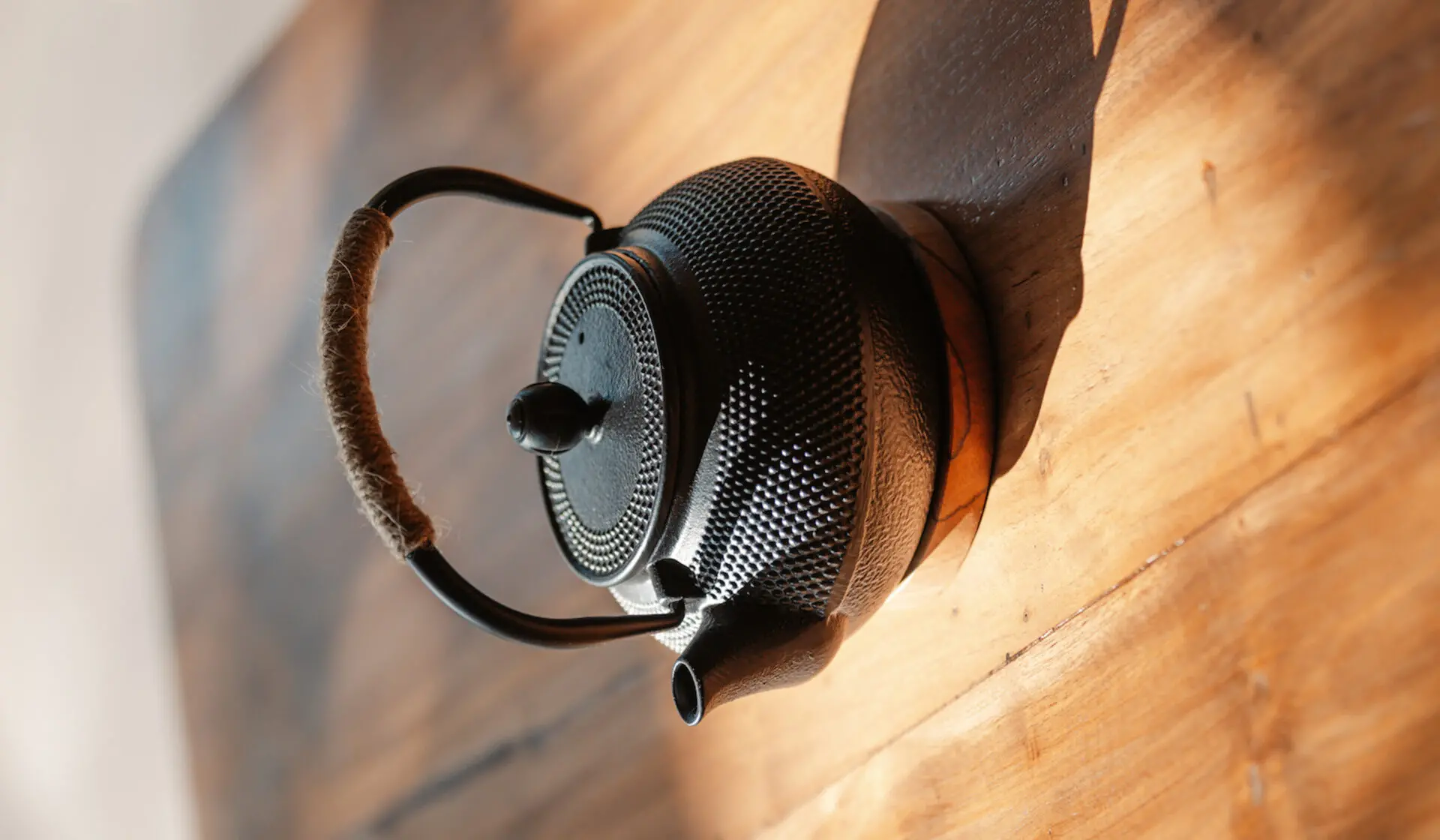Introduction to Kyusu
The Kyusu, a traditional Japanese teapot, is more than just a vessel for brewing tea—it’s a symbol of Japan’s rich tea culture and craftsmanship. Originating from the Kanagawa Prefecture, particularly in the town of Yokohama, this elegant teapot has been an integral part of Japanese tea ceremonies for centuries. Its design, typically featuring a curved body and a side handle, is not only aesthetically pleasing but also highly functional.
Kyusus come in various materials, most notably clay and porcelain, each offering unique benefits and enhancing the overall tea-drinking experience. The porous nature of clay kyusus allows the teapot to absorb flavors over time, leading to a deeper and more nuanced taste in each subsequent brew. Porcelain kyusus, on the other hand, is non-porous and allows for a purer tea flavor, ideal for discerning palates.
The art of using a kyusu extends beyond the mere act of brewing; it encompasses the entire experience, reflecting the philosophy of wabi-sabi, which appreciates the beauty in imperfection and transience. This teapot encourages mindfulness, inviting users to engage in the ritual of tea preparation and consumption. The Kyusu’s design and functionality meld harmoniously, making it a cherished item not only for tea enthusiasts but also for collectors who admire its craftsmanship.
In this guide, we will delve deeper into the history, types, and proper usage of the kyusu, exploring how this seemingly simple teapot plays an extraordinary role in the world of Japanese tea. Whether you are new to the art of tea or a seasoned aficionado, understanding the kyusu can enhance your appreciation for this timeless tradition.
Types of Kyusu
The world of kyusu is as rich and varied as the teas it brews, with numerous styles and materials that cater to different preferences and brewing techniques. Understanding the different types of kyusu not only enhances your tea-drinking experience but also allows you to choose the perfect teapot for your specific needs. Here are the primary types of kyusu you will encounter:
1. Clay Kyusu
Clay kyusus are renowned for their ability to retain and enhance the flavors of tea. Made from natural unglazed clay, these teapots vary in color and texture, often characterized by earthy tones and organic finishes. The porous nature of clay allows for excellent heat retention and gradual temperature control, which is ideal for brewing delicate green teas. Over time, the clay absorbs the flavors of the tea, leading to a unique and personalized brewing experience. Notably, there are two main sub-types:
- Tokoname Kyusu: Originating from the Tokoname region, these kyusus typically feature a traditional design with a classic side handle. Known for their refined craftsmanship, Tokoname kyusus are often used in formal tea ceremonies.
- Hozan Kyusu: This type, often found in the Hozan region, boasts a rustic appearance with a more hand-crafted feel. Hozan kyusus may vary in shape and size, but they all emphasize natural functionality.
2. Porcelain Kyusu
In contrast to their clay counterparts, porcelain kyusus are non-porous and glazed inside and out. This type of kyusu is celebrated for its ability to brew a clean and pure cup of tea, making it ideal for appreciating the subtleties of high-quality leaves. These teapots are often adorned with exquisite patterns and colors, showcasing the artistry of Japanese ceramics. Porcelain kyusus are versatile and can handle a variety of tea types, making them a great choice for those who enjoy experimenting.
3. Yaki Kyusu
Yaki kyusu, or “fired teapots,” are made from a specific type of clay that is fired at high temperatures, resulting in a sturdy and heat-resistant teapot. These kyusus are designed to withstand higher brewing temperatures, making them suitable for steeping robust teas like oolong or even some black teas. Their durability and unique aesthetic make yaki kyusus popular among both tea lovers and collectors.
4. Glass Kyusu
Although not traditional, glass kyusus have gained popularity in recent years for their modern aesthetic and practicality. These teapots allow you to visually enjoy the infusion process, making it easy to gauge the color and strength of the tea. Glass kyusus are suitable for cold brewing and herbal teas, although they require careful handling to avoid breakage.
5. Specialty Kyusu
In addition to the various primary types, specialty kyusus can be found that incorporate unique designs, sizes, or functionalities. Some may be designed for specific types of tea or feature innovative brewing mechanisms, such as built-in infusers or dual chambers.
Each type of kyusu offers a unique approach to tea brewing and can significantly influence the flavor and aroma of your cup. Selecting the right teapot tailored to your taste preferences will not only elevate your tea sessions but also deepen your appreciation of this beautiful Japanese tradition. As you explore the diverse world of kyusu, you’ll discover the perfect vessel that resonates with your tea journey.
The Art of Teapot Crafting
The crafting of kyusu is an ancient art that blends skill, tradition, and personal expression. This intricate process begins with the selection of high-quality clay, as the character of the teapot is deeply influenced by the material used. Japanese artisans often source specific clays from regions renowned for their unique properties, such as the iron-rich clay from Tokoname or the fine clay from Aichi Prefecture. Each type of clay lends a distinct flavor profile to the tea, making the selection process both critical and personal.
1. Forming the Structure
Once the raw clay is chosen, the artisan begins shaping the teapot. This involves a combination of hand-throwing on a potter’s wheel and hand-building techniques. Crafting the body, spout, and handle requires not only technical skill but also an intuitive understanding of balance and form. Artisans often spend years honing their craft to achieve the perfect blend of functionality and beauty. The shape of the kyusu plays a vital role in heat retention and the ability to pour, making it essential that each element is thoughtfully designed.
2. Adding Decorative Elements
After the initial form is created, artisans often apply decorative elements that reflect their style. These can include intricate carvings, glazes, or inlays. For example, many kyusus feature hand-painted motifs inspired by nature, such as cherry blossoms or waves, which embody the aesthetic principles of wabi-sabi—an appreciation of imperfection and transience. The glazing process is also crucial, as it protects the clay and enhances the visual appeal. Different glazes can create a myriad of textures and colors, adding to the uniqueness of each piece.
3. Firing and Finishing Touches
The final phase of crafting a kyusu involves firing the teapot in a kiln. This process solidifies the clay and enhances its durability. Depending on the type of clay and design, kyusus can undergo multiple firings for added texture and color depth. After firing, artisans often refine the teapot, smoothing out any imperfections and ensuring that the spout pours cleanly without dribbling.
4. The Role of Tradition and Innovation
While the traditional methods of kyusu crafting remain paramount, contemporary artisans often innovate within these age-old practices. New techniques and materials may be introduced, offering fresh perspectives on this time-honored craft. Some potters experiment with shapes, sizes, and even multi-functional designs that may incorporate modern conveniences while maintaining the essence of traditional artistry. This blend of tradition and innovation not only enriches the kyusu’s legacy but also makes it appealing to a wide range of tea enthusiasts, bridging generations of tea culture.
Functionality of the Kyusu: Brewing the Perfect Cup
While the aesthetic appeal of kyusu is undoubtedly captivating, its true purpose lies in brewing exceptional tea. The design and features of the kyusu facilitate optimal extraction of flavors, making it an indispensable tool in Japanese tea ceremonies. Here are some key functional aspects:
1. Shape and Size
Kyusus generally have a distinctive round or oval shape that allows for effective agitating of the tea leaves during steeping. This design maximizes the contact between the hot water and the tea, yielding a rich and flavorful brew. Available in various sizes, kyusus can cater to individual servings or larger gatherings, providing versatility for different occasions.
2. The Infuser
An important feature of the kyusu is its built-in infuser or mesh strainer, which is often integrated into the spout or the rim. This design allows loose tea leaves to expand while brewing, ensuring a fuller extraction of flavor without the hassle of separate strainers. The type and size of the holes in the strainer dictate how fine the tea infusion can be, giving each kyusu its unique brewing character.
3. Heat Retention
The material and thickness of the clay used in kyusu design play a crucial role in maintaining the temperature of the brewed tea. Thicker walls provide superior insulation, helping to keep the tea hot longer, which is particularly beneficial during longer tea ceremonies or while entertaining guests.
Choosing Your Kyusu: Tips for Tea Lovers
If you’re considering adding a kyusu to your collection or starting your journey into Japanese tea culture, here are some essential tips to help you select the ideal teapot:
1. Consider the Clay Type
Think about the flavor characteristics of different clays. Tokoname clay, for instance, is excellent for enhancing umami flavors in green teas, while Shizuoka clay can bring out delicate floral notes. Choose a clay type that aligns with your preferred taste profile.
2. Examine the Design
Look for kyusus that not only resonate with your style but also demonstrate high craftsmanship. Pay attention to the spout’s design and how well it pours, as a good kyusu doesn’t just look good; it should pour gracefully and without dribbling.
3. Size Matters
Determine the size based on your typical tea consumption habits. For personal use, a smaller kyusu (around 300-400ml) is often sufficient, while larger versions (500ml and above) are ideal for serving guests.
Caring for Your Kyusu: Maintenance and Longevity
To ensure your kyusu remains in excellent condition and serves you for years to come, proper care is essential:
1. Cleaning
Avoid using soap, as it can cling to the porous material and affect the flavor of future brews. Instead, rinse with warm water and use a soft brush to clean any residue.
2. Seasoning
New kyusus may require seasoning before their first use. This is often done by steeping tea in the pot several times to build up a natural patina and enhance the flavor profile.
3. Storage
Store your kyusu in a cool, dry place, away from direct sunlight. This prevents cracks and preserves the integrity of the clay.
Conclusion: The Timelessness of the Kyusu
In conclusion, the kyusu is far more than a mere teapot; it is a vessel steeped in history and artistry, embodying the spirit of Japanese tea culture. Whether you are a seasoned tea drinker or just beginning to explore the world of Japanese teas, investing in a quality kyusu can enhance your experience and elevate your appreciation for this ancient tradition. As you hold in your hands a beautifully crafted kyusu, you hold generations of craftsmanship, cultural significance, and the promise of delightful tea moments waiting to unfold.



Leave a Reply
You must be logged in to post a comment.